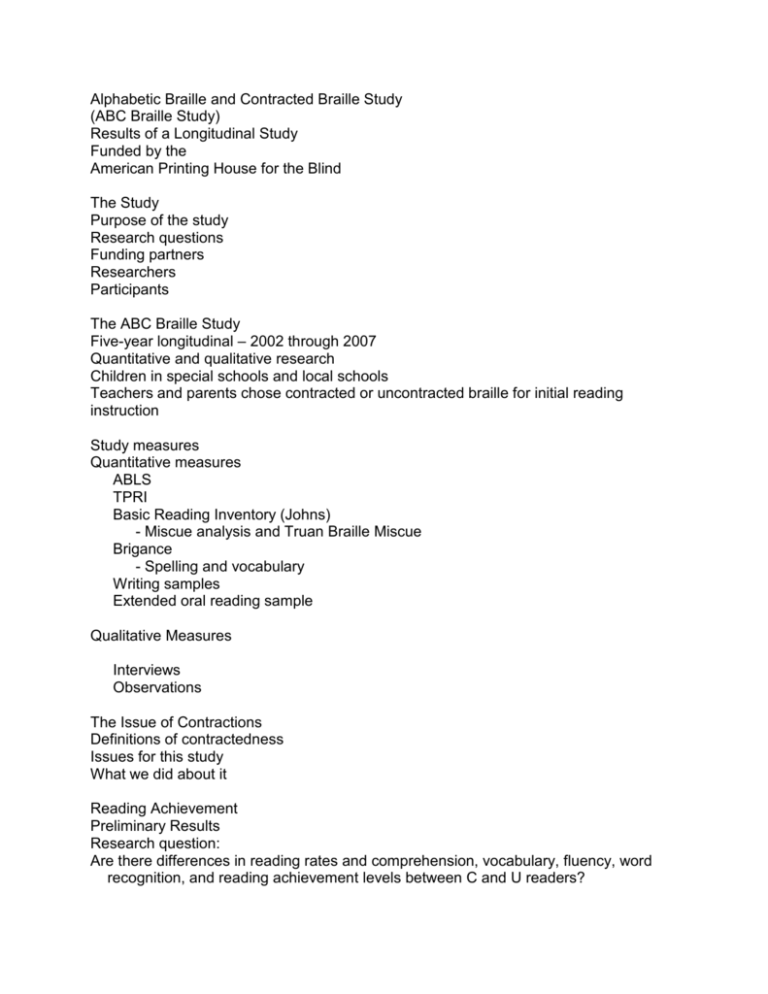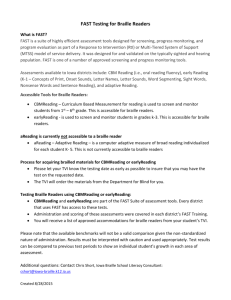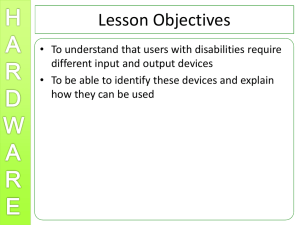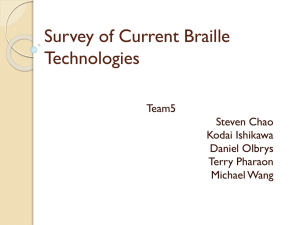Alphabetic Braille and Contracted Braille Study (ABC Braille Study)
advertisement

Alphabetic Braille and Contracted Braille Study (ABC Braille Study) Results of a Longitudinal Study Funded by the American Printing House for the Blind The Study Purpose of the study Research questions Funding partners Researchers Participants The ABC Braille Study Five-year longitudinal – 2002 through 2007 Quantitative and qualitative research Children in special schools and local schools Teachers and parents chose contracted or uncontracted braille for initial reading instruction Study measures Quantitative measures ABLS TPRI Basic Reading Inventory (Johns) - Miscue analysis and Truan Braille Miscue Brigance - Spelling and vocabulary Writing samples Extended oral reading sample Qualitative Measures Interviews Observations The Issue of Contractions Definitions of contractedness Issues for this study What we did about it Reading Achievement Preliminary Results Research question: Are there differences in reading rates and comprehension, vocabulary, fluency, word recognition, and reading achievement levels between C and U readers? Reading Achievement Over the years of the study, only about half of the students maintained or showed expected growth in achievement in vocabulary, spelling, and reading level. Reading Vocabulary (Brigance) Spelling (Brigance) Basic Reading Inventory Independent Reading Level Texas Primary Reading Inventory At the Kindergarten levels, students did well at letter identification and sound/letter linking. By second grade, most students had not mastered complex configurations such as vowels, diagraphs, and orthographic patterns. There was no relationship between contractions learned and performance on the TPRI. Reading Achievement 1. Over half of the students are below grade level in reading as measured on the Basic Reading Inventory. 2. A higher number of contractions is statistically related to higher achievement in the Basic Reading Inventory in each grade from 1 to 4. Reading Speed There is no correlation between the number of contractions taught and the reading speed as measured on the Basic Reading Inventory (in words per minute). Braille Miscues (Truan) Very few reading errors were related to the braille code. Teaching contractions early & quickly is associated with higher scores Reading Instruction Methodology Across reported reading methods (e.g. Patterns, guided reading, other commercial programs, etc.), the scores for reading continuous text (as measured in the Basic Reading Inventory) were poor for students in 1st and 2nd grade. By 3rd and 4th grade, the area of most difficulty was in vocabulary (as measured in the Brigance). Hand Movements in Braille Reading Research Question (Implied): Are there differences in hand movements of C and U readers? Specific Hand Movement Issues Do children’s hand movement patterns remain the same over time or do they change? Is there a relation between hand movement patterns and reading rates? Is there a relation between hand movement characteristics and reading rates? Is there a relation between hand movement patterns and grade level? Do hand movement patterns differ according to whether children were initially taught contracted versus uncontracted braille? Do hand movement patterns correlate to the number of contractions introduced? Do hand movement characteristics correlate to the number of contractions introduced? What is the relation between the number of contractions introduced and reading speed? What we did: Video, Coding, Analysis Types of Hand Movements One-handed reading: left hand, right hand Two handed reading left hand used as marker parallel hands - left and right together split hands - left and right together until near end of line, and then separate scissors reading - both hands used independently Inefficient Characteristics Scrubbing Single Regressions Multiple Regressions Pauses Searching Motions Erratic Movements Right Hand Only Left Hand Only Right Hand Reads; Left Marks Parallel Split Scissor-Like Fashion Why was this important? Only study that looks at hand movement longitudinally Permits us to determine whether hand movements change over time or remain the same If there is a progression to more efficient use of the hands, this should be demonstrated in the data What did we learn? Do children’s hand movement patterns remain the same over time or do they change? Generally speaking… Students who learned using a one handed reading method continued to use a one handed reading method Students who learned using the parallel two handed method progressed into other patterns such as split and scissor techniques Writing Research Question (Implied): Are there differences in writing productions of C and U readers with regard to words per sentence, words per passage, and spelling? Writing and Spelling Procedures Factors to be analyzed Results for 12 contracted/5 uncontracted students There were no differences in the mean number of words per passage OR the mean number of words per sentence between 8 high and 7 low achievers 12 quickly contracted and 5 slowly contracted students There were significant differences in both groups by Number of Correctly Spelled Words per Passage Students in the highly contracted group spelled an average of 91.6% words correctly. Students in the low contracted group spelled an average of 81.1% words correctly. High Achievers averaged 89.6 correctly spelled words per passage Low Achievers averaged 80 correctly spelled words per passage. Children rarely checked their own work while writing or after writing Younger students often used nonstandard fingering on the braillewriter Social Interactions and Literacy Environment Preliminary Results Research questions: Are there differences in the quantity and quality of literacy and interactive experiences between contracted/uncontracted readers? Are there differences in attitudes towards reading and writing in children between contracted/uncontracted readers? Literacy and Interactive Experiences Observations in literacy activities including: Reading activities Writing activities Library & story time Braille instruction including use of Nemeth Code Research Findings Preliminary results indicate that there are no differences in the number of social interactions between students who were initially taught uncontracted braille versus those students initially taught contracted braille over time. Research Findings Continued No differences in social interactions between high tier & low tier students When we examined contractivity & social interactions, we found differences between the level of social interaction and the level of contractedness. Types of Social Interactions Social engagement: Interactions between peers for enjoyment (95 occurrences) “I got to go to the beach this weekend.” Helping: One partner assisting another (89 occurrences) “What page are we on?” Types of Social Interactions Assigned interactions: Student being directed by teacher(46 examples) “Robert, you read to Johnny.” Reading: Partners engaged in a reading activity with no adult directive (10 examples) (Reading stories in the library, playing a phonics game) Blind interest: Others showing interest in special tools or equipment(3 instances) “What’s that machine called?” “Can I use your braille writer?” Four of the six (66%) most socially interactive students were on or above grade level in reading. Two of five (40%) least socially interactive students were on or above grade level in reading. What Do these Data Tell Us? There were no statistical differences in social interaction. However, qualitatively: High tier & highly contracted students’ social interactions were more active & engaging Low tier & lowest contracted students used more passive interactions & did not engage spontaneously Family Responses for High Tier Students Most families knew the braille alphabet They had braille books at home Most families read print books more than four times per week #1 goal for families: learn to read and write braille Family Responses for Low Tier Students Half of the families knew the braille alphabet Four of seven students had braille books at home Half read print books to students one to two times per week, and half read print books more than four times per week #1 goal for families: 4 self-help skills, 2 make friends, 1 learn to read & write braille Student Attitudes The only differences between groups on the Student Questionnaire were between High Achievers and Low Achievers. High Achievers more often said they liked reading there was nothing they disliked about braille Low Achievers more often said they disliked features of the code (contractions) did not like anything about braille or they gave no answer. What Do You Like About Learning Braille? Reading stories Learning to read and write Learning to read and write contractions Math Learning the BrailleNote It’s fun! Braille is special What Do You Dislike About Learning Braille? Kids talk while I’m trying to read Writing over if something is wrong Reading Grade 2 Takes up too much space Taking tests in braille Braille writing makes my fingers tired Who Teaches You Braille? TVI (80%) TVI & Paraeducator (10%) TVI & Classroom Teacher (5%) Paraeducators (2%) Myself (2%) Family (1%) Do You Read At Home? Ninety-nine per cent of the students in both groups read at home across each year of the study Less than 1% of both groups did not read at home Who Reads to You? What Do Friends Want to Know About Braille? How to write it How to read it How braillewriters work Can they learn it They want to write stuff How the bumps work Can they use my BrailleNote What Do Friends Do With Braille? Feel the bumps Read it Write notes Play games I teach them how to read it Make words Talk about it Not much Read sentences More questions than answers This research demonstrated relationships between data. It did not describe cause and effect. Therefore, we cannot tell you WHY these results occurred. 1. Why did high achievers know more contractions…. ? It might have been… Teachers introducing more contractions due to student ability. More reading experience. More effective reading instruction in the regular classroom. This research demonstrated relationships between data. It did not describe cause and effect. Like all students, these students were individuals… I observed a child who struggled with reading braille in his first grade class because new contractions appeared do often. The paraprofessional expressed her concern about not knowing whether to let him decode the contractions and fall behind, or whether she should tell him the contraction so he could move on. 2. Why did better readers have more positive attitudes? • Are they better readers because – They are more curious and interested in braille? – They are able to read better and therefore feel better about reading? – They received a different type of instruction? 3. Why are the better readers more often active social participants? TIM, a capable reader: Peer reads the morning math problem to Tim. They work on the problem together. The peer writes their answer on the math paper. Bob, a struggling reader: Peer asks B if he put his name on his paper and he says yes. A peer takes B out into the hallway and read him a book, no braille. She takes him to the computer and reads him questions.” Why might there be a difference in social interactions? Is social status associated with academic competence, as it is with sighted students? Are better readers also more capable in negotiating social interactions? Does academic proficiency encourage initiation from other students? Questions we may never be able to answer with reliability… Would fast readers have been even better if they began without contractions, became fluent readers, and then acquired contractions? How does classroom teaching methodology affect braille outcomes? How much does innate intellectual ability play in the development and rate of learning to read? Key message #1 Contractions facilitate braille reading, but they should be introduced at a rate appropriate for each student’s ability and interest. At the beginning of the study teachers stated their intention to teach contracted or uncontracted braille. – Most introduced letters and alphabet words first – Beyond that point, there were wide variations in sequence and rate of introductions. – Students were often exposed to contractions they had not formally learned. Expected areas of concern with contractions did not materialize Spelling errors were not related to contractions. Reading achievement was positively related to the number of contractions learned. Hand movements were unrelated to contraction use. Consider introducing contractions more slowly if the student is… unable to follow along in silent reading and due to time needed to decode contractions unable to recall and write both contracted and uncontracted spellings of words unable to tell about what has been read after a sentence or two TVIS in the study tried to balance Inclusion of the child in the general reading environment with Individual instruction in the use of contractions And materials that were available ONLY in contracted or uncontracted braille Key message #2 Reading is a process. Overemphasis on braille instruction in isolation can distract from the process of learning to read and write.* Difficulties in reading for most students were evident in…. We have work to do! GAPS IN VOCABULARY increased with grade level. READING LEVEL improved with grade level but still remained low compared to peers. WRITING PRODUCTIVITY was limited, and students rarely edited their own writing. What will make a difference? Increased service is NOT the main solution. Higher achievers in the study did not receive more services. Braille rich environments Braille materials in school libraries, class bulletin boards, groups materials such as names on work charts Opportunities for parents to learn braile beyond the alphabet Classmates who know the braille alphabet and can write simple notes and messages on the braillewriter Meaningful use of braille in activities Reading from a chart of choices. T picks housekeeping with three others. Two are wearing fireman’s hat and one a graduation gown, but all are making a meal. Mary and a 5th grade student alternate reading a Beverly Cleary book , followed by a brief discussion of what was read. Ed asks Pete to read his new Curious George book to him. One friend brings over a furry puppet for Ed to feel. As a TVI, your role is NOT just teaching the braille code. You can make a difference by… – Working within the classroom, with teachers and paraprofessionals – Making sure that classrooms are braille accessible – Teaching reading along with the classroom team Literacy must be meaningful in a context beyond the instructional setting! (Picture of John Callahan cartoon with blind man spraying Braille graffiti on a wall).





